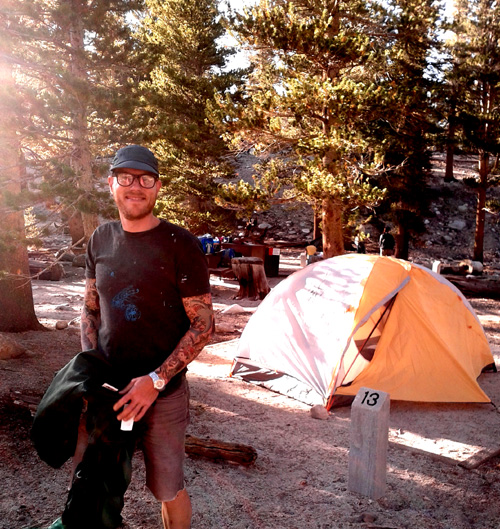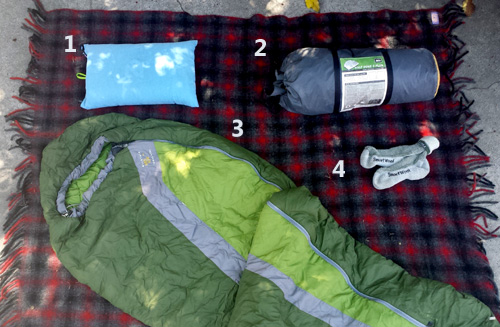
Setting up camp isn’t difficult, but it is worth taking time to do it right. If you set yourself up correctly, your evening will be seamless and relaxing. If not, you’ll likely spend most of your time frustrated in the dark.
I’m splitting this into three posts to focus on each section of camp. Here I’ll talk about setting up your camp sleeping area. In my next posts I’ll talk about setting up your camp kitchen and setting up a camp hangout space. I’m including general rules that should apply to just about any type of camping in any type of climate. If you have any hints, even if they are more specific, please include them in the comments below. I’ll also be highlighting some of our must-have gear at the end.
Step 1: Find Your Space
Pick out where to sleep before you do anything else. This spot matters. You want it to be flat and free of poky debris. You want it to be sheltered from weather, especially wind. Find the flattest area and drop all your stuff.
Step 2: Pitch Your Tent
Set up your tent with nothing inside. Place it in the position that looks the flattest, with a corner facing into the wind. Then get inside, and lay down. Take note of anything poking you through the tent floor, and pull it out. Also pay attention to any slight angle of the ground. You want your heads above your feets, and you don’t want to end up steamrolling your neighbor, or rolling yourself out the door.
Once you’ve picked the perfect spot and angle, lay down the footprint, put your tent on top of it and stake it down. The stakes should be angled toward the tent at about 45 degrees. They should be hammered all the way into the ground so no one trips over them. Do this step even if you’re sure the night will be windless. The wind will surely come if it senses any weakness.
Step 3: Set Yourself Up for Later
Do you live in an area that is prone to surprise rainstorms, dew, or any kind of condensation? Does it get really cold at night? If the answer is yes, or even maybe, you should put your rain fly on your tent. If you’re sure the answer is no, you probably still should, but at least have it easy to find in the middle of the night.
Stuff all your stuff sacks together in your tent bag, and then put the rain fly inside it. Keep this in your tent, in the corner by your feet, just in case.
Then, pull out your sleep gear. Unstuff your sleeping bag and allow it to refresh in loft. If you have a self-inflating air mattress, roll it out and open the valve. If you have an air-only mattress, give it a few breaths so you don’t have to do it all later. Fill the whole thing if you’re willing.
Step 4: Be Ready for the Temperature to Drop
Go through your clothing, and pull out everything you will want to wear as it gets colder. Place these things on top of your sleeping bag for easy location in the dark. Also find your headlamp and put it somewhere you’ll be able to find, like your tent attic, or just around your neck. And make sure there’s a pair of clean, warm socks deep inside your sleeping bag. These should stay in your bag throughout your entire trip. Its nice to know you’ll always have something snuggly and clean to put on, no matter what your feet went through during the day.
Now you’re ready to move on to the rest of camp, and you’ll be thrilled when its time to crawl in.
Roundup: A Few of Our Favorite (Sleeping) Things:

- Nemo Fillo– This pillow is a mix of memory foam and air, allowing for any type of sleeper to customize it to their liking. Its great for glamorous backpacking (a little bulky) and car camping.
- REI Half Dome 2 Plus– This is a mansion of a backpacking tent (I purchased it on accident thinking I had the regular “2”), but its the only tent I need. Durable, big enough for a big dog and lots of stuff, but I take it backpacking using the “fast pack” method (no tent body) and it works great.
- Mountain Hardwear Lamina 35– I’m all about down if it makes sense for you, but if you’re looking for some of the perks of synthetic (affordable, plays better with water, vegan), this is a great option. Its shockingly compressible for the warmth it provides, and costs less than $200.
- Smartwool Hiking Socks– If I took a career test today, I’m sure it would spit out “gear tester” as the top choice. If it can be destroyed, I’m gonna be the one to do it. There are a lot of great socks out there, but these are still the best. Worth the money cause they’ll last you as long as it takes you to lose them. And they just get softer with every wash. These socks come with me on every trip.
Underneath- Pendleton Blanket– Its always great to have a little extra warmth, just in case. Whether sitting around the campfire or just adding one extra layer of protection from the chilly side of the tent, this blanket should be your camping blanket. Its tough and its outdoorsy. It’ll last you a lifetime.

We often organize camps, but what we care about most is sleeping at night and the weather. The sleeping bag is needed and ensure to keep the body warm, especially children and the elderly. It will ensure our health during the time camping organization.
Excellent tips! How well your campers sleep most often makes it breaks a trip. Particularly for short distance camping, I would advise laying an inexpensive tarp below the tent & extending a bit beyond the edges. This can help prevent twigs and condensation from sneaking in through the bottom of the tent. It also eases staging/ cleanup.
Emily, Thank you so much for all of your Excellent Tips and all. Lovin’ and Livin’ it all. So intrigued, can’t stop reading your Info Items. I’m just “pretending” I’m camping in my Cute new Mobile Home with half of my things still in one if my twi storages. This Grandma just turned 67, in June and ready to get back to some Camping after several years of none. Lol. Blessings to you.